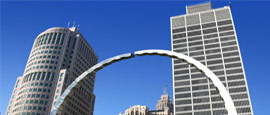Detroit History
Detroit has been around since 1701, when the French founded a fort and missionary outpost here. One of the Midwest’s oldest cities, this metropolis has been overseen by three powers: France, Great Britain, and the United States. It grew quickly and by the early 20th century was one of the largest cities in the country.
It almost wasn’t to be, however, when in 1805 a huge fire caused untold damage and nearly ended the city’s existence. The fire allowed for a complete city redesign and planners implemented a baroque-style layout, with boulevards and a number of impressive parks.
Up to the time of the American Civil War, the city’s proximity to the Canadian border made it a key location, and a central part of the underground railroad system.
After the Civil War, Detroit was ripe for expansion and it became a huge centre for commercial ventures and a hub for global trade. Many wealthy industrialists moved to the city and the affluent neighbourhoods that grew up around town.
The carriage trade thrived here and provided the perfect backdrop for Henry Ford, founder of the Model T, to build his first ever car factory in 1899.
As Ford spawned competitors such as General Motors and Chrysler, they too set up in Detroit, soon turning the city into the head of the world’s automobile industry. More cars meant more jobs, and between 1900 and 1930, the city's population increased from 265,000 to over 1.5 million.
Wartime was a time of transition for Detroit, as factories transitioned from producing cars to military vehicles and bombers. The city became known as ‘The Arsenal of Democracy.’
The decline in motor manufacturing in the US and subsequent globalism eventually meant hard times for the city, and its profile briefly became one of urban decay and poverty.
However, recent redevelopment projects are breathing new life into Detroit’s historic streets, particularly around downtown, midtown, and the riverfront.
Did you know?
• Detroit served as a last stop on the Underground Railroad for slaves trying to reach Ontario, Canada.
• Opening its doors in 1977, the Marriott hotel at the Renaissance Center was the world’s tallest hotel. Today it is still the tallest in the US.
• The Donovan Building, home to Motown Records from 1968 to 1972, was demolished in 2006 and turned into car parking for the Super Bowl.
Do you have any Feedback about this page?
© 2025 Columbus Travel Media Ltd. All rights reserved. No part of this site may be reproduced without our written permission, click here for information on Columbus Content Solutions.




 You know where
You know where